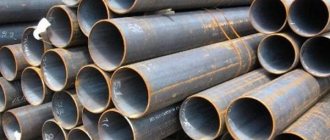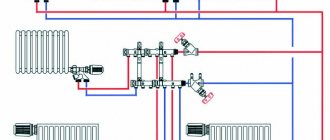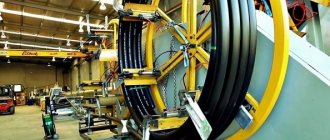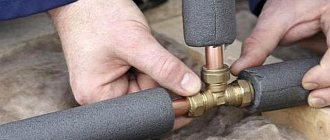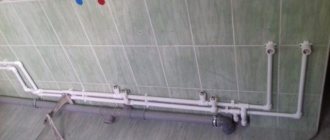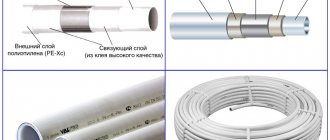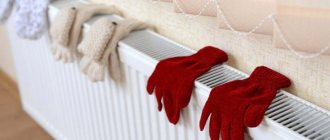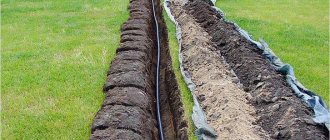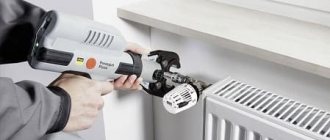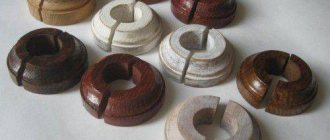In this article, I will tell you how to correctly install the collector distribution of water supply pipes in an apartment. What causes water hammer, why does the temperature drop in the shower and how to do everything correctly so that you don’t have anything like this.
This article will be useful to those who are planning to install water supply pipes in an apartment with their own hands and do not yet know where to start, as well as to those who have purchased an apartment in a new building and plan to make high-quality repairs and a reliable water supply system there.
Not all craftsmen who undertake turnkey renovations in an apartment will be at all concerned about the correct installation of the water supply. For many, the main thing is to make the price tag cheaper than others and how everything will be done fades into the background.
Installation according to the collector circuit
Principle of organization of collector systems
Do-it-yourself collector distribution of water supply in an apartment is carried out according to the following principle - the central branch does not have branches, but is connected to a collector, to which, in turn, the supply lines for each device are connected.
When installing heating systems, collectors are installed in special cabinets (when implementing a scheme for houses with several floors, collectors are installed on each floor). Cold and hot water supply systems are installed in the same way. In apartments, water supply collectors are conveniently installed behind the flush cistern in the toilet. The collector principle of supplying water or coolant is also called radial, and it has its own characteristics for water supply and heating systems. These nuances deserve close attention.
Manifold cabinet design diagram
Installation of collector water supply
The junction of the collector with the central pipe is equipped with a ball valve to allow a general shutdown of the water supply. The valve is complemented by a pre-filter (coarse) filter, which traps large insoluble inclusions that can damage other equipment.
If you follow the flow of water, after the coarse filter there should be a liquid flow meter (meter), and after it there should be another filter that removes smaller inclusions (compared to the first).
The next element of a well-designed water supply pipe distribution system in an apartment is a check valve, which prevents the reverse flow of liquid from the collector into the central pipe when the water supply pressure decreases.
Only after the equipment listed above is the connection to the collector made. Each collector outlet is equipped with its own tap to turn off the branch’s water supply.
The photo shows an example of water distribution in a collector-type apartment
When choosing and installing a collector, one of the determining factors is the number of water consumption points. It must correspond to the number of outlets, and to be able to connect additional plumbing equipment in the future, you should choose collectors with a large number of outlets. Those of them that are not used in the system until a certain point are provided with stubs.
If the central branches of both cold and hot water supply enter a house or apartment, the installation of water supply distribution in a collector-type apartment is identical in both cases. If there is only a central cold water supply, one of the outlets of the cold water collector directs the liquid to the water heater, from where the heated water flows into a separate collector for hot water distribution.
A radial water supply project must take into account not only the number of water consumption points, but also the distance from the collector to each of them. The optimal point for installing the collector is the location closest to the maximum number of consumption points, so that the distances are approximately the same and the outlets do not require too many pipes.
A description of the types of pre-filters is here.
If you have to choose a water heater, we recommend reading this material. In it you will find a comparative analysis of storage and instantaneous water heaters.
Collector heating
The collector heating circuit is implemented as follows:
- The boiler supply fitting is connected to the pressure pipeline, which supplies the coolant to collector No. 1.
- The outlets of the first collector are connected to the upper fittings of the radiators installed in the house.
- A second collector is mounted next to collector No. 1, the taps of which are connected to the lower radiator connectors.
- Manifold No. 2 is connected to the injection pump, and it, in turn, is connected to the receiving fitting of the boiler.
- At the highest point of the circuit, an expander is cut into it, corresponding to the heating circuit (open or closed).
The diagram shows the heating manifold wiring
If there is a central water supply and heating, the collector wiring diagram for heating devices is implemented in a similar way, with the exception of the absence of a boiler, expander and pump.
For the system to operate efficiently, it is important to choose the correct location for installing the collector. It is optimal to place it in the geometric center of the house; the distances from it to all radiators, which are usually located under the windows, will be approximately the same
What is a collector?
When installing a water supply system from scratch or replacing an old one, you need to think about the location of all consumers: toilet, washbasin, washing machine.
In a typical apartment, the number of plumbing fixtures varies from four to ten. Experienced plumbers recommend their customers to install a water collector.
A water collector is a kind of distributor, which is an important plumbing element of a cold and hot water supply and heating system. It is installed on the central riser and hidden in the plumbing closet. Access to the distribution comb should not be blocked by furniture or sewn tightly into the wall. However, professional repairmen will give the engineering unit an aesthetic appearance.
Installation stages
All work to create the wiring of the water supply system in the apartment has the following sequence:
- First of all, emergency valves must be installed on the riser.
- Next, meters are installed, as well as water filters.
- The next step is to install the manifold, after which ball valves are installed at the outlets.
- Now all plumbing fixtures are connected.
- The last stage is to check the entire system for functionality.
If the water supply distribution is to be created in a new building or in an ordinary apartment where the entire system is being completely replaced, then it will not be difficult to do everything yourself.
Please note: if you are installing pipes in a fairly old building, first of all you need to check the condition of the main riser there, since it may be necessary to initially replace it due to wear.
How to install?
Before installing a water distribution unit for cold and hot water supply, give an accurate answer to the following questions and consider the following points:
- How many water consumers are there on site? The number of collector outlets should be the same or slightly greater than the number of consumers. Excess branches are closed with plugs.
- What type of pipes will be used to install the water supply? It is necessary to purchase devices designed specifically for pipes made of the selected material.
- Estimate in advance the position of all engineering elements in the space of the plumbing cabinet (you can make markings on the wall). Please note that a water meter and a water filter are installed in front of the distribution comb. The convenient location of all devices facilitates maintenance and repair work.
- Get reliable fastening - a poorly secured distribution unit can lead to depressurization of connections and damage to the pipeline.
- Before installation, make sure that you have all the necessary consumables on hand: sealing material, gaskets, adapters.
Installation of the water distribution unit occurs in the following sequence:
- Install the inlet shut-off valves on the water supply riser.
- Install the meter, filter and check valve.
- Connect the manifold and securely fix it to the wall
- Install a water supply to each consumer. Secure the pipes with fasteners.
This operating algorithm will allow you to avoid errors. Regardless of whether the collector is needed for water supply or heating, its installation is the same. Such wiring requires more time, skill and money, but pays off quickly and provides comfort in further use. Collectors are appropriate not only in cottages and large houses, but also in apartments.
Advantages and disadvantages
First we need to talk about the disadvantages of the collector system. Why is not all apartments equipped with a collector distribution of water pipes? The answer here is quite simple: you have to spend a lot of money to create the system. There is much more work to be done than when creating a tee system.
So, to power a washbasin and toilet, for example, you will need five meters of pipes for tee wiring, and nine meters of pipes for collector wiring. In addition, special shut-off valves for manifold wiring are expensive.
If renovations in an apartment do not involve a global replacement of water pipes, then you will feel the difference between one pipe on the wall and six pipes.
Therefore, most often a collector system is created when the entire water supply system is changed and it is possible to hide the pipes in special boxes or in the wall. Undoubtedly, collector distribution of water pipes has advantages.
In a small apartment, such a feature may not mean anything to the owner. However, when it comes to hotels and large establishments, such a system is a real godsend.
And what then should you do if, for example, in a hotel, a pipe bursts in one of the rooms? Cutting off the water supply to an entire hotel is suicide, especially if the establishment has a high star rating. The hotel's rating will drop the moment the water is turned off. But if you close the water supply to one room from the collector, that’s a different matter.
The collector system is particularly beneficial for heating systems. For example, you can reduce the temperature on one of the radiators using a throttle valve. In the water supply system, you can limit the use of water, for example, on the sink, where children often like to play. What if they leave the tap open and walk away?
No, the apartment will not flood, but in a few hours, until the adults discover the open tap, about seven to eight cubic meters of water can flow on the meter. If the tap is opened halfway, the numbers on the meter will be half as large.
One more situation can be imagined. With tee wiring, a shower and toilet are connected. You take a shower, the hot water is diluted by the pressure of cold water. Then at this time your wife went to the toilet and flushed the toilet with water from the tank.
What will be next? The cold water pressure will immediately be distributed equally between the shower and toilet. The fact that water will fill into the toilet slowly is not a problem. But getting caught in boiling water from the shower is not very pleasant. In the case of collector wiring, the water supply to the shower and toilet will be the same in any situation.
What is the advantage
Manifold wiring of the heating system has many undeniable advantages.
These include:
- Convenient operation. As a result, each element can be controlled independently. In addition, you can independently control the temperature anywhere in your living space. If you wish, you can independently turn off several groups of heating devices in one area. The temperature in other rooms will remain the same;
- Small diameter pipes can be used. Each branch leading from the comb can supply only one heating device. During installation, you can use pipes of any diameter, which can be distributed in the structure of the screed;
- Easy maintenance. If various problems occur, you can independently disconnect the problematic part of the pipeline. As a result, there is no need to completely shut down the entire system for maintenance.
To form several circuits that differ in different parameters, we recommend using a hydraulic compensator. It will help regulate different pressures and temperatures of the media.
A hydraulic arrow is a capacious pipe, in the output part of which several rows of circuits with independent circulation are connected. Hot water is gradually directed into the hydraulic arrow. Here it will circulate and be independently distributed among different crops.
This heating system has good efficiency. During operation, you can reduce the power of the central boiler and significantly save on fuel costs.
Experts highlight several significant disadvantages of this design. They are as follows:
- Material consumption. To operate, you will need 3-4 times more pipes than with traditional heating. The costs of purchasing material are calculated based on the area of living space;
- A circulation pump must be used. When installing an independent circuit system, you will need to install a circulation pump. Purchasing such a part will require additional costs.
Another weak link of such a design is its dependence on energy. A prolonged lack of electricity will lead to pipes falling behind. Experts do not recommend choosing such a heating system for a region that experiences power outages.
Distribution manifold
Now let's find out why distribution manifolds are needed for water supply. We already know that they allow you to power several water points independently of each other; but how is this useful?
Advantages
Unlike a sequential (tee) system, the scheme of a collector water supply system allows you to avoid a drop in pressure when water flows through an arbitrary device. Simply put, when you turn on the tap in the kitchen, you don’t hear the pained and bitter cries of a family member taking a shower from the bathroom.
Collector water supply scheme for a private house: each device is connected to the collector with its own connection
In addition, a manifold-fed water supply with taps in the manifold cabinet allows you to turn off any plumbing fixture from one point. This is very convenient in public buildings, shopping centers or mini-hotels: if there is a water leak, you can turn it off without even having access to the relevant premises.
Flaws
Alas, the collector water supply scheme has several unpleasant features:
- Material consumption. Obviously, the total length of the water supply connections will be several times greater than with a tee circuit;
- If you install a collector for the water supply, the lines have to be laid hidden (in grooves or screed). Agree that a dozen parallel pipes on the walls of the bathroom and kitchen are a bit of an excess;
Cold water and hot water supply lines are laid in screeds, grooves or routed throughout the basement
Concealed installation entails the difficulty of localizing and eliminating leaks. If the neighbors below begin to get their ceiling wet, it will cost you a lot of work to find a fistula in the water pipe laid in the screed;
Openly laid water supply lines can be changed without damaging the finish
Installation
How to install a collector for the water supply of an apartment with your own hands and route the pipes to the faucets, toilet cistern and other appliances?
A cut-off ball valve, a coarse filter and a water meter are sequentially mounted in the riser (see Water supply meter: everything you need to know about these devices). If necessary, they can be supplemented with pressure reducers and pressure gauges;
In this water supply system, the installation of the collector was accompanied by the installation of a pressure gauge
Collector water supply system: size of taps into the riser - DN 20
Distribution manifolds for water supply (cold and hot) are attached to permanent structures with clamps;
Assembling the water supply manifold: ball valves need to be installed on the terminals
Distribution manifold - Valtec water supply manifold is equipped with ball valves at all outlets
- The tap threads or manifold outlets are equipped with adapter fittings to which connections to plumbing fixtures are connected;
- When installed hidden, the connections are thermally insulated. Insulation will avoid the appearance of cracks in the screed or sealing of grooves due to cyclic heating by hot water pipes, and will also reduce heat loss.
Please note: all connections are thermally insulated
What pipes should be used for water distribution?
As we have already mentioned, the water supply scheme we are interested in—collector—implies hidden installation of connections. However, for reasons of fault tolerance, all serviced fitting connections must be installed openly.
The list includes:
- Cross-linked and heat-resistant polyethylene;
- Metal-plastic;
The collector water supply system in the apartment is mounted with metal-plastic on press fittings
Corrugated stainless steel pipe (see Corrugation for water supply pipes: one step away from perfection).
Corrugated stainless steel for water supply
The metal-plastic pipe in the photo collapsed due to water hammer
The only exception to the general rule is polypropylene. Polypropylene pipes are supplied in straight sections, but their connections are maintenance-free and are as strong as a solid section of water supply, so they can be safely laid in screeds or grooves.
Polypropylene manifolds for water supply can be connected directly to polypropylene connections, without additional fittings
Collector design and principle of operation
The direct function of a collector in a water supply system is to distribute one water flow into several flows of equal pressure.
Combs with two, three and four outlets are available. If more branches are needed, the distributors are connected to each other. In this way, a water supply collector is assembled for the required number of outlets.
The collector is connected directly to the riser. On two opposite sides of the device there is a threaded connection (internal thread on one side, external thread on the other) for connecting to the main line and connecting the combs to each other.
A plug or an additional plumbing device, for example, a membrane water hammer absorber, is installed at the free end of the collector.
The diameter of the inlet hole is 20-40% larger than the outlet hole. For example, on a standard manifold for installing water supply in an apartment, the diameter of the inlet hole is 3/4 inch, the outlet hole is 1/2 inch.
1. Manifold with valves. 2. Manifold with ball valves.
Both ball valves and valves can be installed at the outlet openings, allowing not only to open and close the water flow, but also to regulate the power of the flow in this area.
Types of water supply pipes
The main types of pipes used in organizing water supply:
- Copper pipes connected using special solders. The lines are resistant to corrosion and can withstand heating up to 250°C. Pipes are elastic, which allows you to create pipelines of complex configurations. The disadvantage of the material is the formation of a galvanic couple upon contact with aluminum or steel elements. When used in multi-storey buildings, one should take into account the high current conductivity; if the neighbors’ equipment breaks down, the pipeline becomes energized.
- Metal-plastic pipes consisting of several layers of plastic with an aluminum gasket. The products are highly elastic; threaded bushings or crimp elements are used for connection. The products are not used for hidden installations, since the rubber seals at the joints lose their elasticity and allow water to pass through. The advantage is the absence of corrosion; the smooth internal surface prevents the formation of deposits.
- Products made of polybutylene that can withstand heating up to 90°C. The elements are connected using soldering technology, the seam is characterized by increased strength. Due to the high cost, polybutylene products are not widely used; the pipes are used in the construction of heated floors.
- Polyethylene reinforced pipes designed for pressure up to 3.5 atm. Use in water supply networks is not recommended, since the material is not highly durable. The parts are used for distributing water in personal plots or in domestic buildings; the material allows the liquid to freeze. When connecting, it is necessary to install a reducer that reduces the pressure of the water flow to a safe level.
- The lines are made of polyvinyl chloride, which is characterized by high chemical resistance and allows operation at temperatures up to 80°C. The disadvantage of the material is its low resistance to ultraviolet radiation. Soldering or glue is used to connect pipe fragments, but the strength of the joint does not allow water to be supplied under pressure above 3.5 atm. Pipes are used for water supply to technological premises or when organizing irrigation systems; a reducer is provided in the main line to reduce pressure.
- Pipes made of polyisopropylene, allowing elements to be connected by soldering. The material is low cost and allows pressure up to 12 atm. and temperature up to 130°C. The surface of the pipes is rough, but plaque does not form in the inside of the lines. The products are used for organizing risers and for distributing water inside residential or office premises.
When selecting pipes, you should take into account the cross-section of the internal channel, on which the throughput depends. To determine the parameter, it is necessary to find out the required pressure in the lines; the coefficient of pressure drop inside the pipe and at the joints is taken into account. When planning the laying scheme, straight sections should be used, but excessive lengthening and cluttering the branch with reinforcement lead to a drop in pressure.
Tools, materials, dismantling old
Special tools for assembling residential pipelines are described above. To purchase materials, of course, you will need to calculate the footage, nomenclature and quantity locally. Dismantling old pipes is done in the usual ways. It is better to do this after installing and registering the water meter, so as not to turn off water to the floors for a long time.
We will give only one piece of advice: do not use valves with a lever. It is made of silumin or plastic and tends to break off at the most inopportune moment, just when you urgently need to close it. Take ball valves with a butterfly handle. The round, grooved handles also do not break, but wet or sweaty hands slip on them.
Scheme
First of all, it is necessary to correctly draw up a wiring diagram for the future system.
It itself assumes that all pipes will be connected to the manifold through special ball valves.
This makes it possible to carry out repairs on the damaged area without covering all the others. Also, this scheme allows you to distribute the pressure in the system evenly between all devices. But at the same time, the price of this system is very significant, and the distribution link itself also takes up a lot of space.
On paper it is necessary to draw not only the wiring diagram, but also all, even seemingly insignificant points, which include:
- installation locations, as well as dimensions of plumbing fixtures;
- the exact length and position of all pipes;
- places of turns, as well as bending angles of pipes;
- where water filters and meters will be located;
- the maximum possible diameter of communications in each location;
- number of fittings.
This is important: you can begin and carry out all stages of installation only after complete disconnection from the central water supply.
Products on the market
Depending on the material, the cost of products ranges from 400 to 2500 rubles. Collector groups for 200-300 outputs can cost 10,000-40,000 rubles.
There are models from different manufacturers on the market, the popular ones include:
- Watts;
- Uponor;
- Giacomini;
- APC;
- Luxor;
- Fado;
- Caleffi;
- Valtec;
- Bianchi.
The stores offer not only combs, but also accessories. Products without taps are economical. They are used to install individual wiring and make it possible to select suitable parts. Purchasing a product with shut-off valves will make the installation process easier. When assembling the units, the need to install valves disappears.
To adapt the device to the home system, components are purchased. These include valves, valves, and pump groups. Mechanical drives, plugs and pipes are required.
Manifold cabinets are used for wall mounting and maintaining an aesthetic appearance.
Laying methods
With a closed water supply method, all the main elements must be accessible.
This procedure can be carried out in several ways:
- closed;
- open.
It is worth noting that the closed method is not only characterized by increased labor intensity, but also makes it possible to save space in the room. This is very relevant when it comes to small bathrooms.
But it is worth remembering that if this method is chosen, then the installation of detachable connections should be carried out exclusively in the open.
At the same time, we can immediately note the main disadvantages of the closed method:
- inability to conduct a preventive inspection of pipes to examine their condition;
- the need to break down walls in order to carry out repairs in the event of a leak and, as a result, the need for further repairs.
As for the open method, its only drawback is the reduction of free space in the room, as well as changes in its appearance.
But the advantages include:
- low labor intensity of installation, which has a positive effect on the speed of its implementation;
- the ability to see a leak in time and eliminate it;
- ease of repairs on any site;
- the ability to improve the system while using it.
What will you need besides pipes and fittings?
An effective system cannot operate safely without:
- main valve of inlet shut-off valves;
- multi-stage purification filtration station;
- devices for adjusting and setting operating parameters;
- flow control instruments;
- devices for protection against the consequences of accidents;
- other additional equipment.
Each of these elements is necessary for the system to operate smoothly, be monitored, configured, and protected.
Main valve, inlet shut-off valves
This is a device that operates in two positions (open, closed). The task is to cut off the water supply from the riser if it is necessary to carry out repairs or in the event of a long absence of apartment residents. An alternative is valves that smoothly regulate water pressure and operate in an intermediate position. But such valves are more expensive than conventional ball valves.
Filtering devices
The minimum set consists of two types of filters:
Coarse cleaning
Installed at the inlet after the ball shut-off valve. The purpose of the filter is to catch large solid contaminants (rust, scale, etc.).
Fine cleaning
Absorbs small solid suspended particles. Special cartridges with fiber filler are used as filter elements.
Each filter requires periodic maintenance. During rough cleaning, the particles are retained by a metal mesh, which must be removed and washed. There are filter models equipped with a self-cleaning system. You have to buy new fine cleaning cartridges.
Regulating devices
The task of the stabilizing reducer is to maintain a comfortable pressure in the distribution pipes - this is from 3 to 4 bar. You can also use an electronic version - this is a pressure switch, which will eliminate the possibility of water hammer. A sharp surge in pressure can damage washing plumbing fixtures and wiring elements.
Check valves also fall into the category of control devices. They are needed if boilers are to be connected, and they protect the system from spontaneous drainage of water from the tank into the riser when the water supply is turned off.
Metering devices
The use of meter models is regulated by GOST. Installing it is not enough; flow metering devices must be calibrated and sealed. This is done by special water utility services. The device is equipped with a strainer and a check valve. When installing, there must be straight pipes on both sides. This will eliminate measurement error.
Emergency devices
This is a “smart electric valve” - this device protects the wiring from breaks and leaks, and the apartment from flooding. If a hose or pipe bursts, the pressure will drop sharply, and the device will immediately cut off the water supply.
Other auxiliary devices of sanitary cabinet
Properly organized plumbing in an apartment allows you to control operating parameters during operation of the water supply system. For this purpose, pressure gauges are used that measure the water pressure in the pipes. When there are several of them, the presence of a difference indicates a blockage that can be eliminated.
The manifold-distributor is a separate element that is involved in flow distribution. The number of outputs depends on the number of consumer devices. Ideally, each outgoing branch is equipped with a ball shut-off or check valve, depending on the need. Pressure gauges and emergency protection devices are also installed here.
Why do you need a collector?
A water supply system with a separator and a separate pipe supply to each consumer will cost more than a classic wiring. Is it worth overpaying for a collector for water and heating?
- The device is used to regulate water pressure in the apartment. In standard wiring, the pressure in an open tap often decreases if someone opens another tap or flushes the toilet. This threatens not only discomfort, but also burns due to too hot water, which suddenly begins to flow. The well-thought-out diameter of the manifold eliminates pressure problems. No matter how many taps are open in the apartment, the water pressure remains the same.
- There are taps at each outlet that allow you to regulate the flow of water along the branch. If the mixer is being repaired, it is not necessary to completely turn off the supply of cold and hot water from the risers. It is enough to switch only a certain branch.
- The absence of joints and tees built into the wall minimizes the risk of leaks. If a faucet or fitting fails, it can be easily replaced by disassembling the manifold system in the cabinet. The lining in the bathroom will not be damaged.
- If you need to add another consumer to the water supply system, you will not have to redo the entire wiring. Connection will be inexpensive and will not require much time.
When installing a water supply system using a collector, its cost increases. The number of pipes to the collector, be it metal, metal-plastic, polypropylene or cross-linked polypropylene, compared to tee wiring, increases by 8-10 times. However, modern pipes, especially metal-plastic and polypropylene, are not very expensive, so such a system is available to most residents.
Types and types of water supply collectors
Collectors may differ from each other both in their design and in the materials from which they are made. That is why when choosing these devices you need to be as careful and careful as possible.
Brass manifold
The following materials can be used in the production of a water supply collector:
Stainless steel. Its main advantages include resistance to corrosion. In addition, this metal can withstand high temperatures and contact with fire. In terms of overall dimensions, the combs, made of stainless steel, are quite small. That is why they can be easily and without any problems installed inconspicuously in the right place in the house.
It is also worth noting that this material is environmentally friendly. Products made from it have a very attractive appearance. Brass
This material is distinguished by its high strength, which exceeds that of stainless steel. The advantages of brass also include its resistance to corrosion and high temperatures. Combs made of this alloy are characterized by high cost. That is why they are not available to all buyers. Polypropylene. The advantages of such collectors include low weight and resistance to corrosion. The disadvantage of this material can be considered primarily low strength. It is also worth paying attention to the poor resistance of polypropylene to high temperatures.
Also, water supply collectors differ in the method of fastening. The comb model must be selected based on the material the pipelines are made of. In this regard, it is worth highlighting the following types of collectors:
- combs for installing faucets and other plumbing fixtures;
- combs with compression fittings, allowing you to connect pipes made of metal-plastic and polyethylene;
- combs for installation of pipelines made of polypropylene;
- combs for Eurocone, allowing you to connect pipes from almost any material.
Collectors for water supply may also differ in design, implying a particular number of outlets. There can be from 2 to 6. If some of them are not required, such outputs can be closed using plugs.
Which collector should I choose for my apartment’s water supply system?
The manifolds manufactured by FAR have gained the greatest popularity in this area. High-quality collectors at very reasonable prices. Let's classify them as middle class. The line includes manifolds for a standard connection via a union nut and a Eurocone. There are also Russian-language inscriptions on the lambs, which is convenient.
If we consider all the best, then Oventrop is the most expensive.
The number of outlets on the collector must be equal to the number of water collection points.
For example, a standard one-room apartment in a new building, consumers:
- Kitchen (sink) hot water supply + hot water supply (hot + cold);
- HVS dishwasher;
- HVS toilet;
- DHW + cold water bath;
- DHW + cold water sink;
- HVS washing machine.
Such a scheme requires two collectors: 3 outlets for hot water supply and 5 outlets for cold water supply.
General installation tips
Before installing the pipeline, it is necessary to install all fasteners and complete welding work. Pipes that were stored or transported at sub-zero temperatures before installation are kept for at least 24 hours at temperatures above 10°C. Before starting installation, it is necessary to level them and prevent deflections in the future.
Pipes are secured to walls and supports with clamps or hooks. The distance from fasteners to threaded connections must be more than 5 cm
For water risers, pipes with an outer diameter of at least 20 mm are used, for floor wiring - with a diameter of 16 mm and 14 mm. It is better to use as few dismountable connections as possible. It is necessary that all connecting elements correspond to the type (series) of pipes and, like fittings and revisions, are located in accessible places.
Horizontal sections of the water supply system must have a slope towards the drainage fittings to allow water to drain; the slope is made towards the device through which air will escape when the system is filled with water. When installing vertical structures, do not allow them to tilt more than 2 mm per meter.
When installing the pipeline vertically, the hot water supply pipes are placed to the right of the hot water supply pipes. When installing horizontally, the cold water supply is placed below the hot water supply to avoid the formation of condensation.
Close the channels or embed the pipeline only after a test run of the system and checking it for operability, leaks and damage.
When operating a hot water supply, a phenomenon called thermal expansion occurs, which is especially typical for products made of polypropylene. This can cause pipes to lengthen, leading to damage and leaks.
Correct placement of fasteners and self-compensation of such pipeline sections as bends, turns, and “snake” gaskets prevent deformation.
Tee circuit and its features
Technically, the tee scheme for distributing water supply in an apartment is a serial connection - one pipe departs from the riser, to which plumbing and other water-consuming equipment are connected using tees.
The advantages of such a system are:
- economical (with a series connection, a minimum number of pipes is required),
- ease of installation.
The tee scheme for distributing water supply in an apartment also has its disadvantages:
- a large number of connections and serial connection make it difficult to find leaks,
- there is always a risk of pressure drops in the system and a decrease in pressure at the points furthest from the riser when several taps are turned on simultaneously,
- if it is necessary to carry out repair work, a complete shutdown of the water supply will be required, which represents a certain inconvenience,
- Installing tees is not always convenient in small spaces.
An example of a tee water supply wiring diagram.
Tee water supply diagrams are recommended for small apartments . With a small number of consumption points and their location close to each other, many disadvantages become less relevant - in this case it is much easier to coordinate water consumption, which means the risk of pressure loss is minimized.
When installing a tee circuit, the tees are often hidden in the walls or under the floor, which complicates inspection of communications, and during repairs inevitably leads to damage to the finish.
